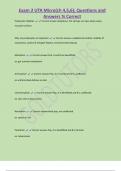Exam 2 UTA Micro(ch 4,5,6); Questions and
Answers % Correct
Prokaryote Habitats Correct answer-ubiquitous: hot springs, ice caps, deep ocean,
mucosal surfaces
Why are prokaryotes so important Correct answer-v adaptive & resilient, stability of
ecosystems, carbon & nitrogen fixation, environmental cleanup
Mutualism Correct answer-Pop. A and B are benefitted
ex. gut nutrient metabolism
Amensalism Correct answer-Pop. A is harmed and B is unaffected
ex. antimicrobial defense on skin
Commensalism Correct answer-Pop. A is benefitted and B is unaffected
ex. skin cells as food source
Neutralism Correct answer-Both pop. are unaffected
ex. spores in soil
Parasitism Correct answer-Pop. A is benefitted and B is harmed
ex. tuberculosis
, Exam 2 UTA Micro(ch 4,5,6); Questions and
Answers % Correct
Prokaryote taxonomy Correct answer-molecular, biochemical, microscopy, and nucleotide
sequences is best approach for classification
Gram Negative Correct answer--proteobacteria
-spirochete
-CFB group
-plantomycetes
-phototrophic
Proteobacteria Correct answer--alphaproteobacteria
-betaproteobacteria
-deltaproteobacteria gammaproteobacteria
epsilonproteobacteria
Alphaproteobacteria Correct answer--oligotroph (live in low nutrient environment)
-obligate intracellular bacteria
-rickettsia: pleomorphic, cocci rods or threads, rocky mountain spotted fever and typhus
-chlamydia: coccoid or ovoid, chlamydia
Betaproteobacteria Correct answer--eutrophs (require many nutrients)
-Bordetella: coccobacillus, aerobic, fastidious, whooping cough
, Exam 2 UTA Micro(ch 4,5,6); Questions and
Answers % Correct
-Neisseria: coccus forming pairs, gonorrhea, meningitis, require moisture and high
concentration of CO2, oxidase positive
Deltaproteobacteria Correct answer--sulfate reducing
-Myxobacterium: coccoid forming colonies
-Desulfovibrio: comma shaped rod, reduce sulfur
-Bdellovibrio: comma shaped rod, obligate aerobes, parasitic infecting other bacteria
Gammaproteobacteria Correct answer--most diverse
-Pseudomonas Aeruginosa: bacillus, aerobic, infections of wounds, urinary, and respiratory
tracts
-Pasteurella Haemolytica: pneumonia in animals
-Haemophilus Influenza: bacillus, pleomorphic, upper and lower respiratory infections
-Vibrio: curved rod shaped, alkaline environments, motile, hypersecretion of electrolytes in
gasto. tract
-Legionella Pneumophila: legionnaires disease, bacillus
-Enterobacter: bacillus, coliforms, noncoliforms, urinary and respiratory tract infection
Epsilonproteobacteria Correct answer--smallest, aerophilic
-Campylobacter: spiral shaped rod, aerobic, food poisoning
-Helicobacter: spiral shaped rod, aerobic, ulcers and stomach cancer




